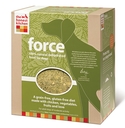
Dog Food
Veterinarian Reviewed on May 27, 2012 by Dr. Janice Huntingford
Dog Food
Dog food is intended for consumption by dogs of various breeds. There are many people that prefer to prepare their own dog food and feed their dogs using ingredients that have been purchased in a grocery or health food store, or they may give their dog a raw diet instead. Then there are those dog owners that choose to feed their dogs on commercially manufactured dog food.
There are a few options when it comes to selecting the best food for dogs. Some dog owners will argue that their dogs have thrived on eating leftovers and scraps from the table for over thousands of years and that commercial dog foods contain poor-quality meats, additives, and other ingredients that dogs should not consume. Then there are others that maintain that commercial dog food is not nutritionally sufficient.
Commercial Dog Food
A majority of store-bought dog food is available in either dry form, which contains 6-10% moisture, or wet canned form, which contains 60-90% moisture. There are semi-moist dog foods available that contain 25-35% moisture.
Dry Dog Food
Dry foods are generally less expensive than canned or semi-moist foods. Dry food is also less likely to spoil than an open can. As well as this, dry food is much more nutritious than canned food due to the high water/moisture content contained in the wet variety.
Dry dog food pellets are produced by one or two methods, extrusion and baking. During the extrusion process, the mix is placed into an expander, whilst pressurized steam or hot water is added. When the pellets are removed from the high pressure, they puff up like popcorn.
The product is then left to dry and sprayed with vitamins, fats and oils, and any other ingredients that are not heat-tolerant.
Wet Dog Food
Wet or canned food has a great deal more moisture than dry or semi-moist food. Because the food is sterilized after being canned, it is very often easier to ensure the sterility of wet food. Wet dog food is generally higher in protein or fat than dry food. Canned food should always be used alongside dry food in order to ensure that the dog is receiving the correct amount of nutrition.
Popular Alternative Dog Foods
• Frozen or Freeze-Dried
This comes in raw or cooked form. The processing stage is skipped when freeze drying which causes less destruction of the nutritional integrity of the food.
• Dehydrated
This comes in raw and cooked form. The products are generally air dried which reduces the moisture to the level where bacterial growths are reduced. The appearance of dehydrated dog food is similar to that of dry food; however the difference between the two is that dehydrated dog food generally includes adding warm water before serving it to the dog.
• Fresh or Refrigerated
This is produced through pasteurization of fresh ingredients. The food products are lightly cooked and rapidly sealed in vacuum packages. It is then refrigerated until it is served. If this type of dog food is not kept at a cool temperature it is extremely vulnerable to spoiling. If it is stored correctly, it has a shelf life of 2-4 months, unopened.
Raw Dog Food
It is believed by many dog owners that the natural diet of an animal in the wild is the best that it can receive. For this reason some dog owners attempt to provide a similar diet for their canine companions. Many so-called holistic pet food manufacturing companies sell organically fed chicken and beef that has been molded into a hamburger patty-style. This food is then kept frozen until ready to use, at which time it is removed from the freezer and allowed to thaw before feeding to a dog. Other instances involve the dog’s owners heating the frozen food and then mixing it in with dry kibble.
Suggested Products
Dog Food
Sign up for our newsletter and receive more articles and the latest pet health updates and special offers.
Our Expert
 Dr. Janice Huntingford
Dr. Janice HuntingfordJanice Huntingford, DVM, has been in veterinary practice for over 30 years and has founded two veterinary clinics since receiving her Doctor of Veterinary Medicine at the Ontario Veterinary College, University of Guelph. She has studied extensively in both conventional and holistic modalities. Ask Dr. Jan

